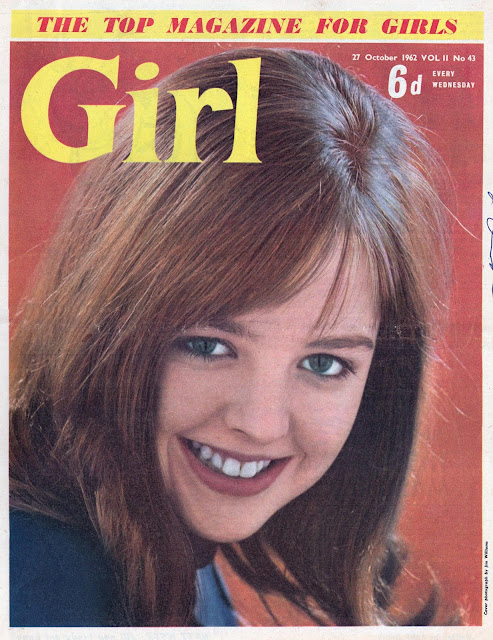There's a bit of a myth that pops up now and then with some people claiming that British comics never featured creator credits until 2000AD broke the taboo in the late 1970s. While it's true that forced anonymity was generally the rule, there were comics long before 2000AD appeared that published credits. Some comics allowed signatures, even if the writers remained anonymous, but in the case of the original Eagle in the 1950s, and its "sister" publication Girl, writer and artist credits appeared alongside most strips. At least for a while. Odhams put paid to that when they took over Eagle in the early 1960s, but from the evidence here, they still allowed writer/artist credits in Girl up to 1962 at least.
Like Eagle, Girl was a tabliod-sized glossy publication and its photogravure print quality allowed artists to produce painted strips in colour or grey wash. The standard of artistry was extremely high. Let's take a look...
Belle of the Ballet, written by George Beardmore, drawn by Harry Lindfield. The artist would later illustrate strips for Polystyle's Countdown comic...
The Family Storey, written by Judy Sanders, drawn by Gerry Haylock, another artist destined to find work in Countdown in 1971. (Countdown, and the comic it was renamed as, TV Action, also ran artist credits on their strips, - but not for writers.)
Send for Sally! written by Peggy Stuart, art by Roland Davies. More about the artist here: https://bearalley.blogspot.co.uk/2009/04/lesser-known-art-of-roland-davies.html
Calling Nurse Abbott! written by Frank Redpath, drawn by Philip Townsend and Leo Davy.
All of these strips deserve reprinting as book collections but unfortunately it's highly unlikely they ever will be. While it's admirable that Rebellion are now honouring the legacy of post-1970 comics, they don't own the rights to earlier material which is sadly becoming ever-more forgotten.
All the strips here are scanned from Girl Vol.11, No.43, dated 27th October 1962. Click the pages to see them full size.









10 comments:
I indexed some early Eagle Annuals for GCD and it was nice to put names in the credits instead of a question mark.
It's a disgrace that so many comics wouldn't credit their creators. Their excuses used to be 1) They didn't want rival comic poaching their artists (which was nonsense as many freelancers worked for various comics), or 2) It would destroy the illusion if readers thought the strips were drawn and not real! (Totally daft.)
The truth is that management didn't want the workforce to get any acclaim. The "know your place" type of thing, wanting artists to be replaceable cogs in a machine (which is why the comics developed a "house style", eg: telling people to draw like Roy Wilson). Sadly, many artists were so conditioned over the years by this bad attitude that even when the companies allowed them to sign their work they declined.
Isn't it lovely art! Thanks for this.
Really top class work isn't it? The quality of British comics in the 1950s and 1960s was exceptional.
I wonder if it could be argued that there's a connection between the quality of the artwork and the artists getting credited? It might be stretching a point, but at the same time knowing your name's going on the pages can't have hurt.
Possibly, as they knew their names would be seen so there'd be no hiding who'd done it. Although I think the standard of illustration back then was extremely high anyway.
I agree some stunning art there especially from Gerry Haylock - I didnt realsie girls comics had such quality art
I think that by necessity, as the stories were about emotional drama, it was imperative that girls comics used illustrators that excelled at drawing the human figure and convincingly realistic settings. These pages really pull the reader in and Girl must have been a compelling read for the kids of that era.
yes I was going to say because the drawings couldn't hide behind explosions and most panels were of normal everyday settings the artist would really have to excel at making the art interesting.
Great work!
Rebellion were or rumoured to be thinking of buying the rest of the comics...don't know the latest..
Love the art..what high standards and great printing..
Post a Comment